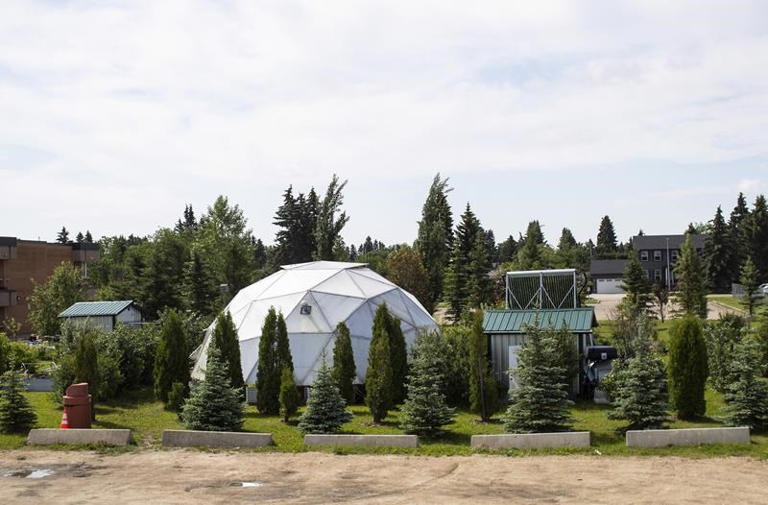Alberta
Beehives and goat farms: Lacombe school shortlisted in global environmental contest

Taylor Perez says she learned more about her passions while tending beehives, goats and fruit trees at her central Alberta high school than sitting through lessons in a classroom.
“These are all skills we don’t learn in regular classes,” says the 18-year-old student at Lacombe Composite High School.
“You’re not going to learn how to collaborate with community members by sitting in a classroom learning about E = mc2.”
Perez and her classmates are buzzing with excitement after their school’s student-led beekeeping program, goat farm, fruit orchard, tropical greenhouse and other environmental projects were recognized in a global sustainability contest among 10 other schools.
It’s the only North American school to be shortlisted by T4 Education, a global advocacy group, in its World’s Best School Prize for Environmental Action contest.
“The projects are coming from the students’ own hearts and passion for taking care of the environment,” says Steven Schultz, an agriculture and environmental science teacher who has been teaching in Lacombe since 1996.
“They are going to be our community leaders — maybe even our politicians — and for them to know what the heartbeat of their generation is (is) extremely important.”
Schultz says the projects are pitched and designed by students in the school’s Ecovision Club, to which Perez belongs, and he then bases a curriculum around those ideas.
The school of about 900 students began reducing its environmental footprint in 2006 when a former student heard Schultz say during a lesson on renewable energy that “words were meaningless or worthless without action,” the 56-year-old teacher recalls.
“She took that to heart and a year later she came back and told me that she wanted to take the school off the grid.”
Schultz and students watched a fire burn down solar panels on the school’s roof in 2010, an event that further transformed his approach to teaching.
“As their school was burning, my students gathered in tears. That day I realized that students really care about the environment and they really care about the projects that they were involved in.”
Since then, 32 new solar panels have been installed, and they produce up to four per cent of the school’s electricity. After the fire, students also wanted to clean the air in their classrooms so they filled some with spider plants, including one in the teachers’ lounge.
More recently, students replaced an old portable classroom on school property with a greenhouse that operates solely with renewable energy. It’s growing tropical fruits, such as bananas, pineapples, and lemons, and also houses some tilapia fish.
Two acres of the school are also covered by a food forest made up of almost 200 fruit trees and 50 raised beds where organic food is grown.
The school also works with a local farm and raises baby goats inside a solar-powered barn that was built with recycled material.
“They breed and milk them at the farm because there are really tight regulations,” says Schultz.
“We take the excrement from the goats and the hay and use it as mulch and fertilizers for our garden. The goats also chew up the grass and allow us not to have to use lawn mowers and tractors”
Perez said her favourite class is the beekeeping program with 12 hives that produce more than 300 kilograms of honey every year.
“I love that they have different roles in their own little societies,” Perez says of the bees.
She says while working with local businesses and groups as a part of her curriculum, she learned she’s passionate about the environment and wants to become a pharmacist so she can continue giving back to her community.
James Finley, a formerly shy Grade 10 student, says the Ecovision Club and environment classes have helped get him out of his comfort zone.
“I made friends, which was a hard thing for me in the beginning. But now I have, like, hundreds,” says the 16-year-old, who enjoyed the lessons he took on harvesting.
“Taylor and Mr. Schultz were the main people that made me stay.”
Schultz says the winners of the contest are to be announced in the fall.
A prize of about $322,000 will be equally shared among five winners.
This report by The Canadian Press was first published Sunday, July 3, 2022.
—
This story was produced with the financial assistance of the Meta and Canadian Press News Fellowship.
Fakiha Baig, The Canadian Press
Agriculture
Lacombe meat processor scores $1.2 million dollar provincial tax credit to help expansion

Alberta’s government continues to attract investment and grow the provincial economy.
The province’s inviting and tax-friendly business environment, and abundant agricultural resources, make it one of North America’s best places to do business. In addition, the Agri-Processing Investment Tax Credit helps attract investment that will further diversify Alberta’s agriculture industry.
Beretta Farms is the most recent company to qualify for the tax credit by expanding its existing facility with the potential to significantly increase production capacity. It invested more than $10.9 million in the project that is expected to increase the plant’s processing capacity from 29,583 to 44,688 head of cattle per year. Eleven new employees were hired after the expansion and the company plans to hire ten more. Through the Agri-Processing Investment Tax Credit, Alberta’s government has issued Beretta Farms a tax credit of $1,228,735.
“The Agri-Processing Investment Tax Credit is building on Alberta’s existing competitive advantages for agri-food companies and the primary producers that supply them. This facility expansion will allow Beretta Farms to increase production capacity, which means more Alberta beef across the country, and around the world.”
“This expansion by Beretta Farms is great news for Lacombe and central Alberta. It not only supports local job creation and economic growth but also strengthens Alberta’s global reputation for producing high-quality meat products. I’m proud to see our government supporting agricultural innovation and investment right here in our community.”
The tax credit provides a 12 per cent non-refundable, non-transferable tax credit when businesses invest $10 million or more in a project to build or expand a value-added agri-processing facility in Alberta. The program is open to any food manufacturers and bio processors that add value to commodities like grains or meat or turn agricultural byproducts into new consumer or industrial goods.
Beretta Farms’ facility in Lacombe is a federally registered, European Union-approved harvesting and meat processing facility specializing in the slaughter, processing, packaging and distribution of Canadian and United States cattle and bison meat products to 87 countries worldwide.
“Our recent plant expansion project at our facility in Lacombe has allowed us to increase our processing capacities and add more job opportunities in the central Alberta area. With the support and recognition from the Government of Alberta’s tax credit program, we feel we are in a better position to continue our success and have the confidence to grow our meat brands into the future.”
Alberta’s agri-processing sector is the second-largest manufacturing industry in the province and meat processing plays an important role in the sector, generating millions in annual economic impact and creating thousands of jobs. Alberta continues to be an attractive place for agricultural investment due to its agricultural resources, one of the lowest tax rates in North America, a business-friendly environment and a robust transportation network to connect with international markets.
Quick facts
- Since 2023, there are 16 applicants to the Agri-Processing Investment Tax Credit for projects worth about $1.6 billion total in new investment in Alberta’s agri-processing sector.
- To date, 13 projects have received conditional approval under the program.
- Each applicant must submit progress reports, then apply for a tax credit certificate when the project is complete.
- Beretta Farms has expanded the Lacombe facility by 10,000 square feet to include new warehousing, cooler space and an office building.
- This project has the potential to increase production capacity by 50 per cent, thereby facilitating entry into more European markets.
Related information
Alberta
Alberta Next: Alberta Pension Plan

From Premier Danielle Smith and Alberta.ca/Next
Let’s talk about an Alberta Pension Plan for a minute.
With our young Alberta workforce paying billions more into the CPP each year than our seniors get back in benefits, it’s time to ask whether we stay with the status quo or create our own Alberta Pension Plan that would guarantee as good or better benefits for seniors and lower premiums for workers.
I want to hear your perspective on this idea and please check out the video. Get the facts. Join the conversation.
Visit Alberta.ca/next
-

 Business1 day ago
Business1 day agoDallas mayor invites NYers to first ‘sanctuary city from socialism’
-

 COVID-192 days ago
COVID-192 days agoCourt compels RCMP and TD Bank to hand over records related to freezing of peaceful protestor’s bank accounts
-

 C2C Journal2 days ago
C2C Journal2 days agoCanada Desperately Needs a Baby Bump
-

 Agriculture1 day ago
Agriculture1 day agoLacombe meat processor scores $1.2 million dollar provincial tax credit to help expansion
-

 Crime1 day ago
Crime1 day agoThe Left Thinks Drug Criminalization Is Racist. Minorities Disagree
-

 Business2 days ago
Business2 days agoNational dental program likely more costly than advertised
-

 Energy2 days ago
Energy2 days agoB.C. Residents File Competition Bureau Complaint Against David Suzuki Foundation for Use of False Imagery in Anti-Energy Campaigns
-

 conflict1 day ago
conflict1 day agoUS airstrike on Iran’s nuclear facilities. Was it obliteration?






